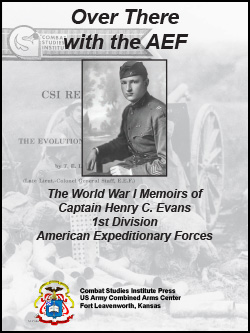
The World War I Memoirs of Captain Henry C. Evans, 1st Division, American Expeditionary Forces
By Combat Studies Institute Press
166 Pages
Published: 2015
When “Grandma Evans” died in 1991, John and Rosalyn Evans fell heir to John’s father’s old Army footlocker, which contained a trea¬sure trove of World War I memorabilia. “We hadn’t realized it before his death, but Pa kept a diary of his war years and had even typed a ninety four-page journal using the notes which he made while ‘over there’ from 1917 to 1919. In addition, Frank and Ella Evans, Pa’s father and stepmother, carefully saved each of the fifty-four letters which their dough-boy son sent to them. They returned the letters to him on his return.” Twenty letters which relate directly to the diary are included for reference.
To read this combined collection is to relive with Henry C. Evans, or just “Pa,” an important era in his life. Each page reflects his integrity, intelligence, courage and delightful sense of humor. We know Pa would want you to read and enjoy his writing. For those who knew and loved Pa, this project should rekindle fond memories. For his progeny who were not so fortunate to know him, including fifty-five and counting great-grandchildren, we hope that this project might acquaint them with this wonderful and heroic man. On 17 September 1995, one hundred years after Henry’s birth, John and Roslyn compiled Pa’s diary and pertinent letters as a gift to their family.
In 2003 the diary was shared with the Reserve Officers Training Corps at The Johns Hopkins University. The diary was such a hit with the cadets and cadre that the single copy became worn and severely dog-eared. In 2004 the Professor of Military Science, Lieutenant Colonel Charles E. Roller, Field Artillery, received permission from the family to retype the diary and add footnotes to give the diary historical context. In addition, more photos were added and the original letters were typed to make them easier to read. The goal of this new project was to significantly increase the audience for this wonderful diary and to use the diary to teach ROTC cadets the values of the US Army, which are so evident in this diary. Those values are: Loyalty, Duty, Respect, Selfless Service, Honor, Integrity, and Personal Courage.
Download the PDF 